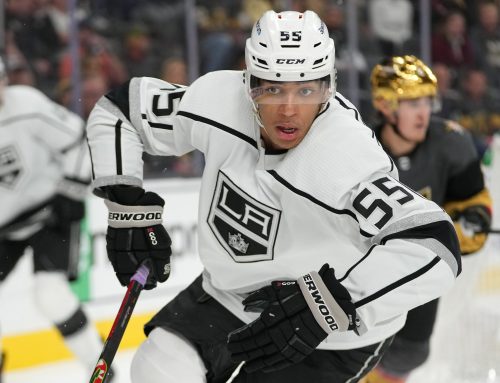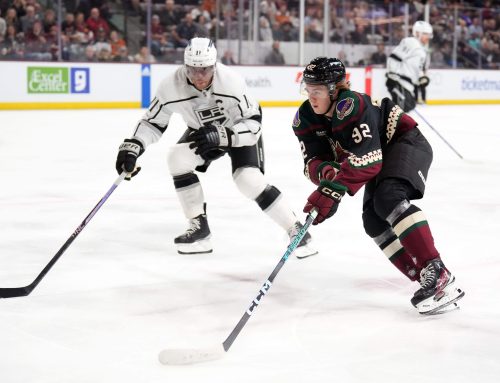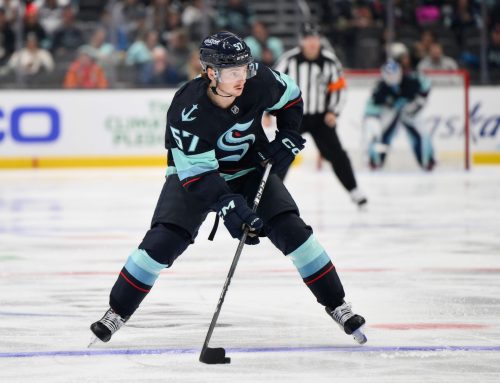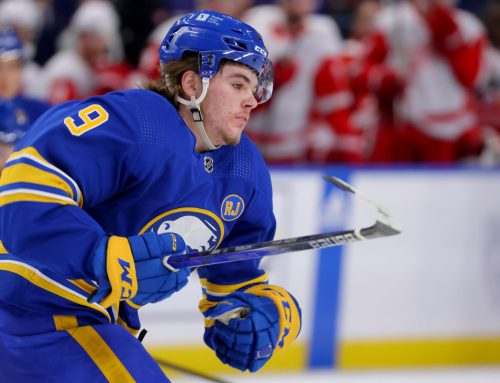The Journey: NHLe vs. NHLz on Bradly Nadeau’s Upside
Ben Gehrels
2024-02-10
Welcome back to The Journey, where we track the development of prospects as they excel in junior, make the NHL, and push towards stardom.
***
Something that caught my eye recently was league equivalency work being developed by EP Rinkside's Chace McCallum. He posted the following chart, which shows the top 20 highest league-adjusted scoring rate draft-year seasons in the last five years (2020-2024).
The 2024 guys are all looking really strong when compared to performances from other draft classes. I was surprised to see Connor Bedard's WHL results (2.51 points/game) outstripped by Adam Fantilli's freshman NCAA campaign (1.81 p/g), but both were historic, and that ranking speaks to the higher quality of competition in the modern college game.
Moving past those two, who is the first name that jumps out to you as a surprise?
Bradly Nadeau (CAR) at 5th, one slot ahead of Alexis Lafreniere (2.15), is wild to me. As McCallum states, this is still a work in progress, so there may still be some adjustments before all is said and done. But still, Nadeau being so high on this list is intriguing—especially given that he fell a fair way to the Hurricanes at 30th overall just last year—and warrants a deeper look into his trajectory and potential upside.
Nadeau earned that rank by posting a 2.09 scoring rate in the BCHL, which is a league that historically has a lower NHLe than the OHL (0.144 vs. 0.08). While those results seem counterintuitive on the face of it, McCallum's work is striving to push past traditional NHLe ratings to create a more flexible way (NHLz) of assessing league rating that can account for year-over-year differences in scoring and quality of competition. Very cool stuff.
Here is his substack if you'd like to learn more.
***
As an aside before we take a closer look at Nadeau, Thibaud Chatel (NL Ice Data) is working on a similar project (Selective Network NHLe), and both he and McCallum have pointed out that the NHL is pulling away from all other leagues in terms of quality over the last five years in particular.
I read that to mean that a performance like Daniila Yurov in the 2023-24 version of the KHL (46 points in 55 games), for example, should be taken with a greater grain of salt than traditional NHLe models would suggest.
Here is Yurov's PNHLe chart from his Dobber Prospects page. PNHLe is a stat built on NHLe that attempts to give us an idea about how well a player might perform (ie. score) in the NHL based on their current performance in a different league. By this metric, Yurov currently projects as having Superstar Potential.

But Frozen Tools' NHLe Calculator—which is super fun to play around with by the way—is based on NHLe work by Rob Vollman (now the Senior Director of Hockey Operations for the Los Angeles Kings) from back in 2015 that uses a translation factor of 0.80 for KHL production.
Given that Chatel has the KHL actually clocking in at 0.448 over the past five years, that is a huge gap that needs to be accounted for.
This kind of cutting-edge work could have a dramatic impact on stats-based prospect evaluation and projection. Equivalency models are a fantastic way to compare the production of junior-level players across a wide variety of leagues and contexts. The more accurately we can compare apples to oranges, the more accurately we can assemble rankings of the top prospects in the game and find little pockets of value that our competitors may have missed.
***
Alright, back to Nadeau, who was initially billed as "a versatile center who lacks high-end tools but makes up for it with a refined offensive mind." Partway through Nadeau's draft year, DP's Sebastian High highlighted his playmaking ability and offensive awareness, noting that his shooting, skating, and handling were all around NHL average—which likely limited his projection to a future bottom- or middle-six role in the NHL.
On DP's final board for the 2023 draft, where Nadeau somewhat surprisingly finished 43rd, however, Hadi Kalakeche noted that he had become a "borderline elite shooter" with a release that was "both extremely powerful and lethally accurate, with a near-perfect form to boot."
The team at Elite Prospects agreed that his hockey sense was above average (6 rating) and that his shot in particular had emerged as a special skill, giving it a very high rating of 7.5 (where 5 is NHL average), which was good for fourth overall in the entire class.
So he is a dangerous offensive weapon with a wicked shot, high-end IQ, and solid playmaking ability. Why did he fall so far in last year's draft then? Presumably, teams were not sure how to properly contextualize his lopsided production in a lower-end league. Plus, he is on the smaller end of things physically (5-10, 163 lbs) and is not an especially strong skater.
A key test of his actual ability, then, arrived this year when he transitioned from the BCHL to the NCAA. If his junior numbers had been artificially inflated due to a weak quality of competition, his college production would presumably have fallen off a cliff.
But the opposite has happened. At the season's three-quarter mark, he currently sits 14th in college scoring (points per game) with 33 points in 25 games. That is good for second on his team as a Freshman, and he has a tidy distribution as well with 14 goals and 19 assists—showing off that balanced scoring he displayed at lower levels.
This level of production at such a young age has spiked his star potential in the Hockey Prospecting model—which again is based on NHLe metrics. Nadeau now sits at a 50% chance of posting star-level production over the course of his career. Even taken with a grain of salt, these are greedy, rub-your-hands-together kind of numbers.

In terms of the 2023 class, that places him 9th overall in Star Probability, just behind Zach Benson (BUF) and just ahead of Riley Heidt (MIN), Leo Carlsson (ANA), and Gabe Perreault (NYR). Illustrious company.

Compared to all the names around him, it feels like Nadeau is not yet getting the mainstream recognition in fantasy that he deserves. He has proved pretty decisively this year that his BCHL production was no fluke and that he deserves to be considered in the upper echelon of forward prospects.
But he surprisingly did not even get invited to Team Canada's World Junior Camp. Especially given that the team struggled to score overall, there were many vocal critics about the choice to leave Nadeau off the roster.
Nadeau also does not yet feature on Dobber's Top 200 Forward Prospect ranking. I have encountered managers in some of my leagues that put a good deal of stock in those rankings without supplementing much from other sources. That can create a value mismatch that could help you get your hands on Nadeau at a bargain discount. He will surely enter the Top 200 as soon as this month, however, so there is a brief buy-low window right now that will likely close soon.
Looking ahead, while he still has some significant hurdles to overcome, including trying to earn opportunities in Carolina's stacked prospect pipeline, Nadeau currently projects as a top-six NHL talent whose one-timer would add a significant weapon off the half wall with the man advantage. If I had to take a stab at his upside, I'd say a balanced 30-30 type season with a shot at 65+ points feels realistic at this point.
***
Thanks for reading! Follow me on X @beegare for more prospect content and fantasy hockey analysis.





 DAL
DAL VGK
VGK EDM
EDM L.A
L.A T.B
T.B BOS
BOS TOR
TOR VAN
VAN NYI
NYI NSH
NSH
